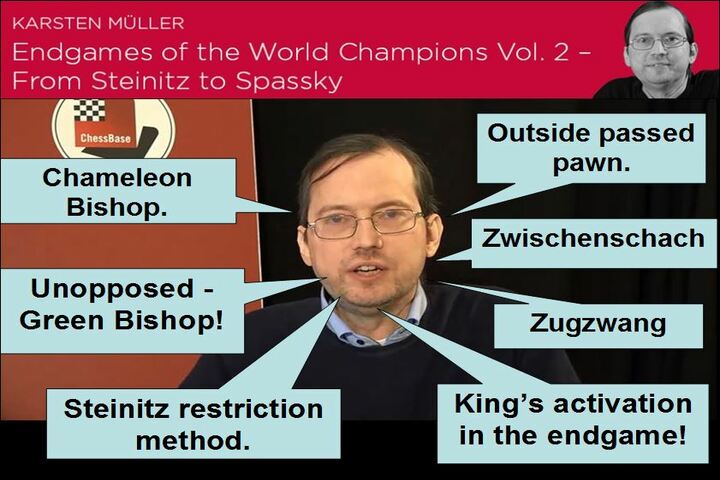A review of Volume 2
I was listening to an interview on the Perpetual Chess Podcast recently and one of the questions was how to learn the endgames. The guest suggested one should get a collection of games by different champions like Rubinstein, Capablanca, Smyslov, and review the games starting from the beginning of the endgame.
This video series offers viewers the opportunity to do just that — but with a wide selection of endgames covering ten world champions from different historical periods, plus a bonus section on Morphy. No need to buy ten books, and waste a lot of time sifting throuhg the material.
In fact, some of these champions are famous specifically for their endgame skills — noteably Capablanca who even had one book dedicated soley to his endgames. Smyslov is another world champion who wrote a book on endgames which is still a classic and a must read. But this is, in a sense, our blessing today. We have GMs like Mueller who grew up reading the books I just mentioned and can reinterpret that knowledge for us in a new, more efficient format.
This month I'll have three weekends tournaments. Then, of course, there are other distractions from our quest for chess mastery: family life, kids out of school, work etc. But thanks to ChessBase and Mueller, I can increase and enjoy my endgame prep for each tournament, with the limited time I have.
For one month I've decided to prepare for my tournaments giving preference to studying endgames. I also try to keep my interest up by adding new tools, books or DVDs. Because I believe one can learn more by keeping the attention high, which also helps with retaining the material studied.
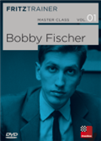 No other World Champion was more infamous both inside and outside the chess world than Bobby Fischer. On this DVD, a team of experts shows you the winning techniques and strategies employed by the 11th World Champion.
No other World Champion was more infamous both inside and outside the chess world than Bobby Fischer. On this DVD, a team of experts shows you the winning techniques and strategies employed by the 11th World Champion.
Grandmaster Dorian Rogozenco delves into Fischer’s openings, and retraces the development of his repertoire. What variations did Fischer play, and what sources did he use to arm himself against the best Soviet players? Mihail Marin explains Fischer’s particular style and his special strategic talent in annotated games against Spassky, Taimanov and other greats. Karsten Müller is not just a leading international endgame expert, but also a true Fischer connoisseur.GM Mueller begins the DVD showing the Steinitz method of restriction using the bishop pair. I admit I didn't know such idea, or that it was typical of Steinitz.

There is a lot of chess wisdom to be learned from Mueller's narration. The above position needs to be converted technically into a rook and bishop vs rook and knight. Mueller says today such endgame would be called Fischer's endgame, dropping a hint to look at the endgames of the legendary player in order to grow more in our endgame understanding.
Fischer is treated fully in volume 1 of this endgame series of DVDs, and if one has the Master Class volume dedicated to Fischer, there's also endgame material to study. But the point here is that Champions like Fischer learned from classic champions like Steinitz, and gained their technique thanks to the study of great games and the practice in tournament. I believe in Fischer's time one would learn the endgames, and the art of analysis, thanks to adjournments. Today we don't have such possibility anymore, but we still need to learn endgames, and know how to analyze a position.
Steinitz
As just mentioned, the first section of the DVD is on Steinitz. Mueller gives some biographical notes to better understand some important moment in this world champion's life. That will help us to put Steinitz's life in the historical chess period in which he lived. The Steinitz section is made up of six videos in which Mueller explains some important endgames played by Steinitz, and one interactive video in which Mueller shows an endgame position and then ask the viewer to take Steinitz's role and win, giving feedback for good and wrong moves.
I'd like to show a position which I found interesting, and could be used for training purposes. In fact, it can be played against the engine within the diagram below. White just played 17.a3?? a blunder. How should Black continue and win the game? (It's partly tactical, but then the real training part begins, when one must be able to convert the material advantage into a win).
Of course the DVD is full of positions which can be used by a coach to test and improve a student's endgame knowledge, like in the following one. White just played 38.h5 how would Black win? (Again, this position can be played against an engine from the diagram.)
I also believe we must pay attention to Mueller's evaluation of the endgame positions, because his words reveal the knowledge we must acquire. For example the following position is defined as a "technical endgame" by Mueller. This means we must play such position, and learn to win it.
If one has the ChessBase Account, it can be played against Fritz online, giving the player not only a library of endgame videos, but also a library of positions to practice and learn from.
 The name Emanuel Lasker will always be linked with his incredible 27 years reign on the throne of world chess. In 1894, at the age of 25, he had already won the world title from Wilhelm Steinitz and his record number of years on the throne did not end till 1921 when Lasker had to accept the superiority of Jose Raul Capablanca. But not only had the only German world champion so far seen off all challengers for many years, he had also won the greatest tournaments of his age, sometimes with an enormous lead. The fascinating question is, how did he manage that?
The name Emanuel Lasker will always be linked with his incredible 27 years reign on the throne of world chess. In 1894, at the age of 25, he had already won the world title from Wilhelm Steinitz and his record number of years on the throne did not end till 1921 when Lasker had to accept the superiority of Jose Raul Capablanca. But not only had the only German world champion so far seen off all challengers for many years, he had also won the greatest tournaments of his age, sometimes with an enormous lead. The fascinating question is, how did he manage that?Lasker is the second world champion treated in this collection. There are a total of ten videos explaining his endgames, and two interactive videos where one needs to find the right moves, as played by Lasker.
Even in the non-interactive videos, Mueller often asks questions about the position, so viewers can always pause the video manually and try to find an answer. This is important because often we cannot afford a GM to teach us, but thanks to Mueller wise questions, we understand critical moments, and when we need to stop and think, like we would do in a game.
In the first video, as he does with Steinitz, Mueller begins with a brief biographical sketch. In Lasker's case, most top players are impressed with the longevity of his reign: 27 years! In fact Lasker's long time competing in chess is rivaled only by Smyslov and Kortchnoi.
Mueller does a good job to examine both sides. Often he doesn't limit himself to showing how good Lasker was, but also finds ways for the other player to draw or defend.
The following position is one such example. Black can draw if he defends precisely. Try to play it against the engine. Surely some practice will help you hone your defensive skills, even if the engine wins all the time.
This position is really dense in variations, and perfect for those who want to learn the art of analysis.
Capablanca
The material on Capablanca has been divided in different types of endings — minor piece endings, Rook endings, Double rook endings etc. — for a total of twelve videos plus two interactive videos.
I find also simple pawn endgames sometimes difficult to win or draw. For example the following is taken by the game Flohr vs Capablanca in 1935. White just played 49.♔xd3, can you draw against the engine?
I'd like to point out how much we can improve, if we just try to analyze some pawn endgames.
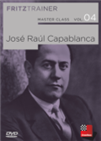 He was a child prodigy and he is surrounded by legends. In his best times he was considered to be unbeatable and by many he was reckoned to be the greatest chess talent of all time: Jose Raul Capablanca, born 1888 in Havana.
He was a child prodigy and he is surrounded by legends. In his best times he was considered to be unbeatable and by many he was reckoned to be the greatest chess talent of all time: Jose Raul Capablanca, born 1888 in Havana. The following comes from the gamed Ed. Lasker vs Capablanca in 1915.
White just played 32.♔d3, and Capablanca was able to win. But maybe White didn't defend like an engine would. Try it yourself. The point here is to gain experience in these endgames, to play better tournament games.
While illustrating the endgames Mueller asks over and over: "How to continue...??" This question is something we'll hear also in our tournament games, and it will be a good way to focus, and ask ourselves something which will give us direction in the endgame.
Alekhine
Alekhine gets ten videos of endgames. In each video, Mueller points out also at possible natural moves one would think to play, and show why such moves are positional mistakes which would give the opponent counter-play.
To link Capablanca and Alekhine, I'd like to show the end of a game, for which Mueller has made a video, in which there are four queens!
Euwe
We come then to what many considered an interim world champion, Euwe, who lost the title as soon as Alekhine regained his sobriety. Euwe however is more important as chess organizer and of course FIDE president. Many don't know that in 1946, it was thanks to Euwe that a qualifying system gave us the interzonals and candidates system to select the future challenger to the World Champion for nearly 40 years. Ten videos of endgames, and one interactive video are dedicated to Euwe. Through the different endgames, Mueller teaches also the importance of losing control of some important squares, and how it would affect the game. Some don't consider Euwe a "real" World Champion, because he had a real job (one to actually pay bills and have a family, retirement etc.), and differently from most world champions, thanks to his writing skills, a lot of amateurs and club players benefited from the wealth of chess literature he left behind.
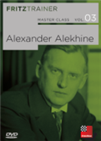 On this DVD GMs Rogozenco, Marin, Müller, and IM Reeh present outstanding games, stunning combinations and exemplary endgames by Alekhine. And they invite you to improve your knowledge with the help of video lectures, annotated games and interactive tests
On this DVD GMs Rogozenco, Marin, Müller, and IM Reeh present outstanding games, stunning combinations and exemplary endgames by Alekhine. And they invite you to improve your knowledge with the help of video lectures, annotated games and interactive testsTry this Euwe endgame, from a game played against Olland in 1920. Olland as Black has played 33...♚g6 against the engine it can be a good calculation exercise.
Botvinnik
Botvinnik, who is the most representative world champion of the so called Soviet School of chess, reigned for a long time. He has twelve videos and two interactive clips dedicated to him. Mueller shows us how some broken pawn structures can be good for some minor pieces, the knight can be such an example of a piece which can use the holes in the enemy pawn structure for one's own advantage. I found the following game, with a beautiful rook and pawns endgame, which clearly show us why we need to study the games of world champions:
Smyslov
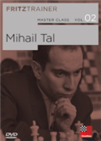 On this DVD Dorian Rogozenco, Mihail Marin, Oliver Reeh and Karsten Müller present the 8. World Chess Champion in video lessons: his openings, his understanding of chess strategy, his artful endgame play, and finally his immortal combinations.
On this DVD Dorian Rogozenco, Mihail Marin, Oliver Reeh and Karsten Müller present the 8. World Chess Champion in video lessons: his openings, his understanding of chess strategy, his artful endgame play, and finally his immortal combinations.Smyslov is dealt with in eleven normal and two interactive videos. For those who want to know more about Smyslov's endgames, he wrote a book, with 150 examples mainly taken from his games. Definitely a worth read for those who aspire to play at master level. And for those who don't like to read, luckily there are the dozens of DVDs on the endgame authored by Mueller!
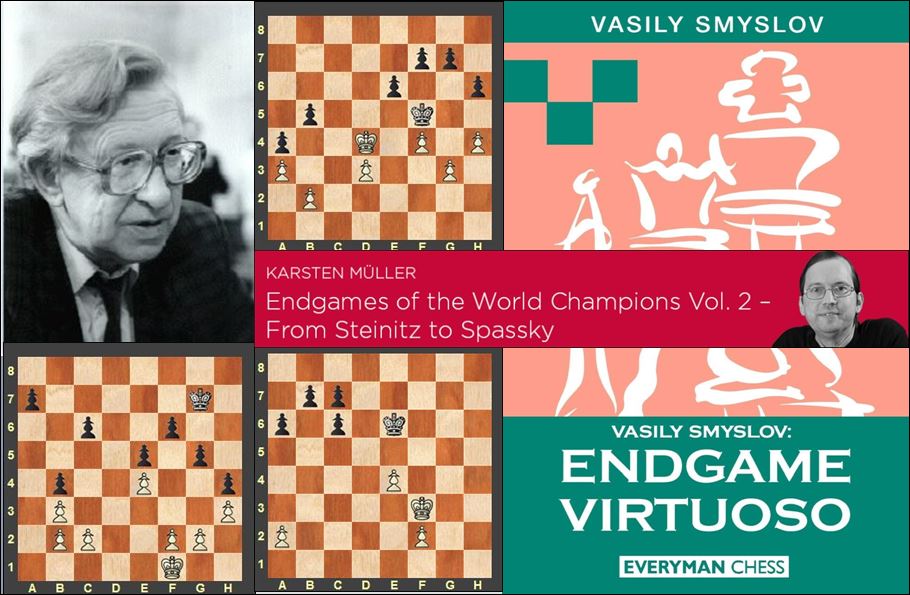
Tal
One of the most loved champions, Tal is also known as "the magician" for his magical tactics. He gets twelve videos divided into three sections: Six of magic endgames, three on rook endings and three of legendary endgames. To know him only for his prowess on tactics wouldn't be fair to him, since like all great champions he studied the endgames and developed the technique to convert a minimal advantage into a win.
I've begun to collect games which inspire me, and I must admit they were mostly miniatures. But thanks to this DVD on the endgames, I've begun to make some collections, for each champions, of endgames I love. Here a small sample of five amazing endgames played by Tal:
Petrosian
Petrosian is famous for his python squeezing style. He clearly had a deep positional understanding, and strong defense. Watching his games one understands the exchange sacrifice. Petrosian had an incredible understanding of minor pieces versus rook. Mueller mentions how he labeled the knight vs bishop endgame the Andersson endgame, but one could use also the term: Petrosian's endgames, because the Armenian really had an incredible feeling for understanding when the knight was better, and how to capitalize such advantage. This section is made up of eleven videos of endgames, plus two more interactive. Here a sample of games played by Petrosian which have some very interesting endgames.
Spassky
And finally we hit the last world champion of this series: Spassky, who's covered by twelve videos and two more interactive clips.
Spassky is the champion made famous by Fischer and the Match of the Century. A Match which went quite beyond chess, and quickly became a comparison between two different economical systems: Capitalism vs Communism. Spassky is a great world champion, slightly overshadowed by Fischer, the Legend. He has some really great games and, like all world champions, some great endgames. One beautiful game, whose endgame has been annotated by Mueller in a video is the following I share here: nowadays these two great players are both former world champions. It's funny to think Karpov used what is known as Fischer's defense in the King's Gambit Accepted.

Morphy
The bonus section is dedicated to Morphy. He wasn't a world champion, but he's considered the first unofficial world champion, since his genius and chess intuition, or chess understanding, are similar to Fischer's. Morphy was quite ahead of his time. Eleven videos and and extra interactive video are dedicated to him.
This wealth of videos can surely enrich everyone's endgame understanding just through sheer exposure to the mass of material, and the recurring ideas, manoeuvers, and geometrical laws common to every endgame. There is also another reason to study deeply this DVD. Lately I was reading this book by Gata Kamsky on his chess games.
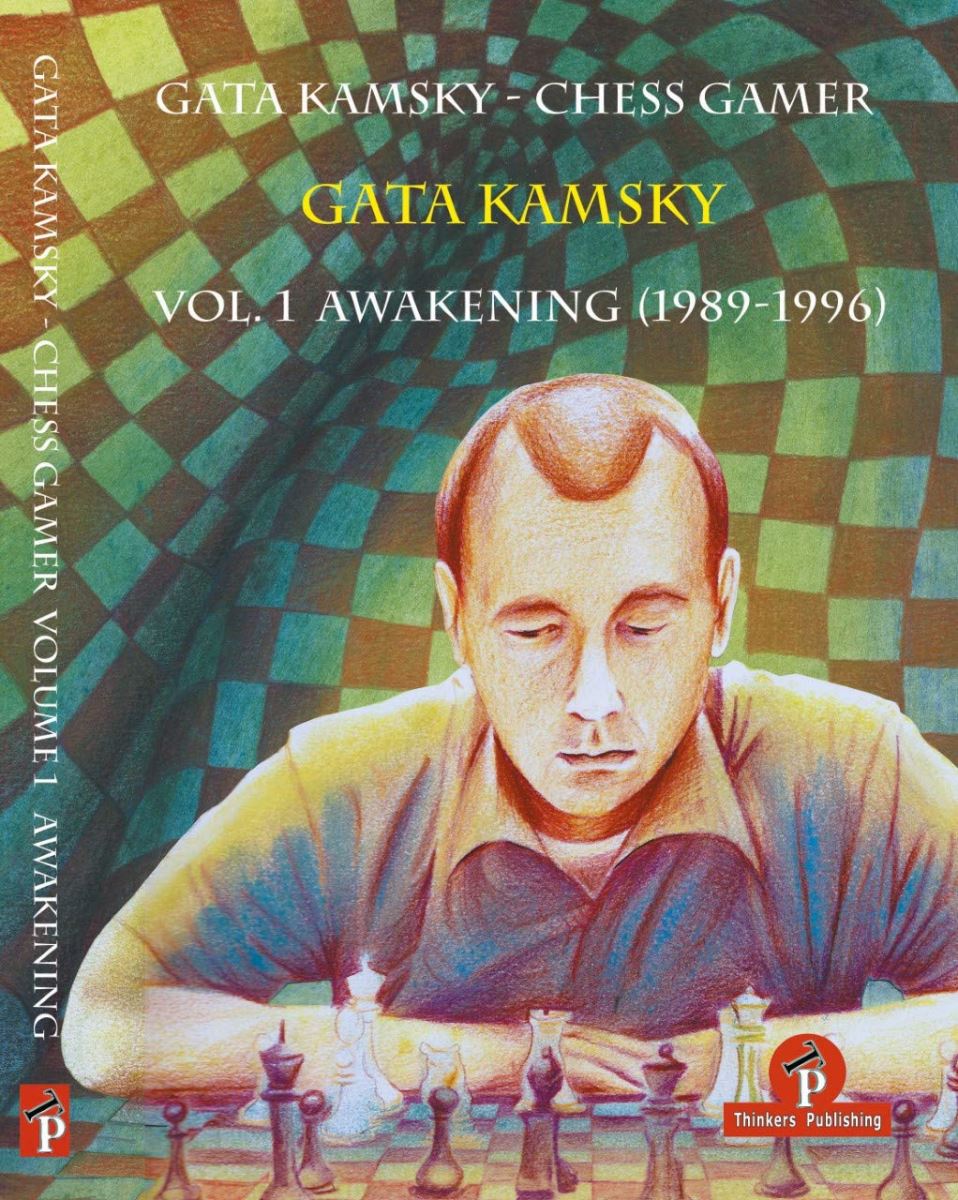
One reviewer argued the analysis were too long, and dense. But when I finally received the book, I realized Kamsky had to spell out some ideas which would have been evident if one knew the endgame. Practically, game after game I read long analysis by Kamsky which were intended to show the reader why he took a certain decision in the middlegame. And we can see he takes decisions in the opening and middlegame already thinking about which endgame will result, and its likely outcome.
Nowadays amateurs rely on engines to evaluate a position. But the engine cannot really convey chess knowledge, and a mere number doesn't automatically translate into a win especially if our endgame technique is poor. Instead, when we read annotated games we find even more cryptic evaluations, like: space advantage or bishop pair advantage. For a titled player at GM/IM level such advantage is clear, because he knows how to use it, and he has seen it in many examples throughout his career. For an amateur such evaluation doesn't mean much.
One of the strengths of this FritzTrainer is how Mueller shows these advantages applied to many games. For example in the section on Steinitz we find multiple examples of the bishop pair winning against the knight pair. This is a first step in growing as chess player, to understand such evaluation plays out in practice. Then the next step is to make it happen in our own games.
The way I used the DVD is the following: Each evening I had time away from family and distraction, was enjoyed on a different champion, following Mueller's video-lectures. Within a month I was able to work through them all.

Final thoughts
At the moment, some world champions are still missing from the Master Class series, and I don't know when they will be published. For Steinitz, Smyslov, Euwe, Petrosian, and Spassky the material we find in this DVD is totally new, while for some Champions, the material may also be found on their respective Master Class DVDs.
Honestly, I got into this series because I consider it a mere quarter of what I would pay for one hour of training with a GM while here we get 13 hours of endgame explanations!! Yes, the value of this DVD is immense. 13 hours of lessons with a GM would be about USD $1300 — instead for less than $30 I have a GM at home who shows me some of the most important endgames played in chess history, for a ridiculously low price.
Kudos to Mueller for collecting all the material in one DVD. The DVD is worth having for teaching us something about the different world champions, especially in today's modern times, where we spend all our time doing tactics. It's a masterpiece to return from time to time, when we want to enjoy titanic battles which were won thanks to great endgame skills. Such knowledge, if only it would rub off on us, could help us earn easy points in our tournament games.
Links
